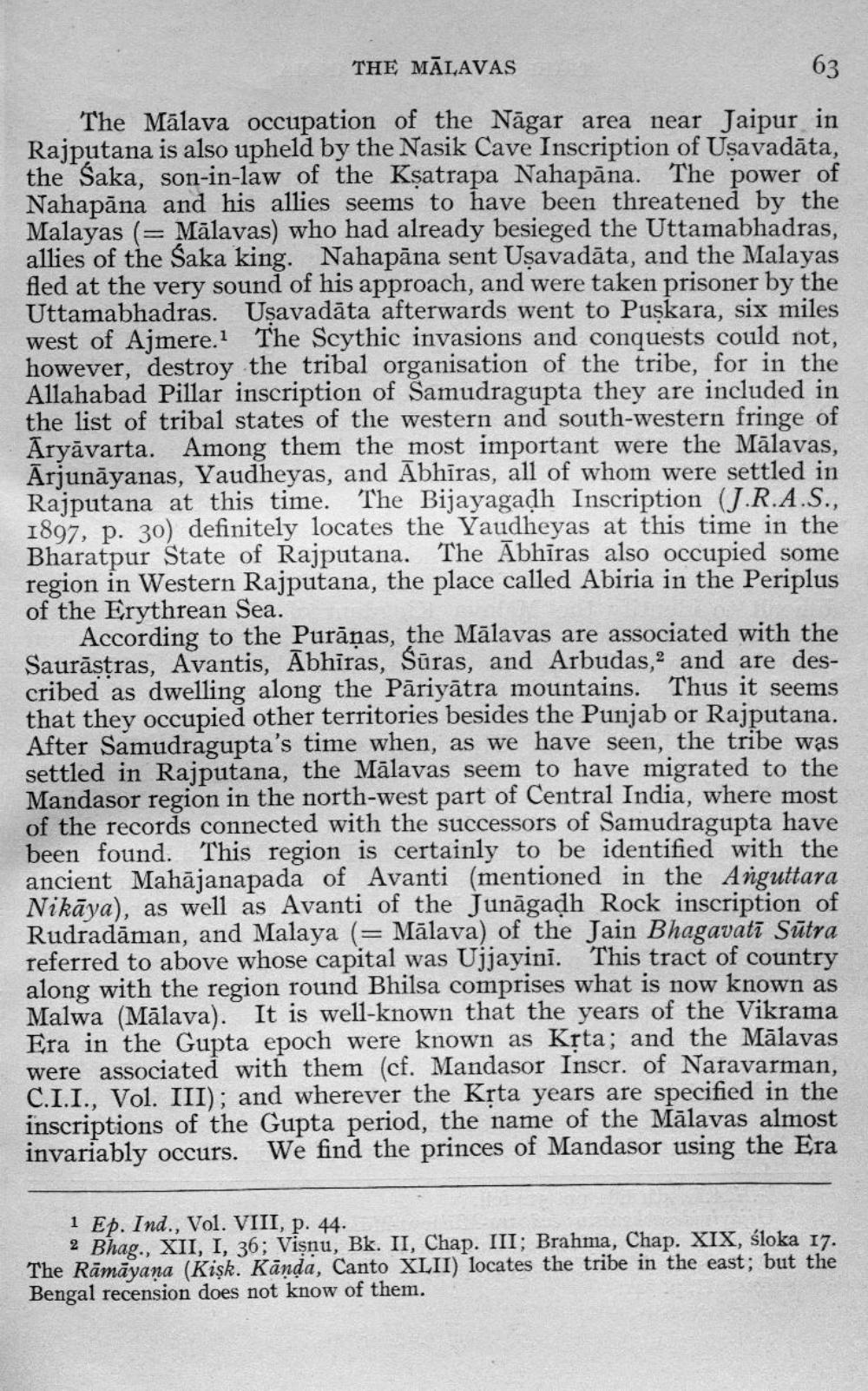________________
THE MĀLAVAS
The Mālava occupation of the Nāgar area near Jaipur in Rajputana is also upheld by the Nasik Cave Inscription of Uşavadāta, the Saka, son-in-law of the Ksatrapa Nahapāna. The power of Nahapāna and his allies seems to have been threatened by the Malayas (= Mālavas) who had already besieged the Uttamabhadras, allies of the Saka king. Nahapāna sent Uşavadāta, and the Malayas fled at the very sound of his approach, and were taken prisoner by the Uttamabhadras. Uşavadāta afterwards went to Puskara, six miles west of Ajmere. The Scythic invasions and conquests could not, however, destroy the tribal organisation of the tribe, for in the Allahabad Pillar inscription of Samudragupta they are included in the list of tribal states of the western and south-western fringe of Āryāvarta. Among them the most important were the Mālavas, Ārjunāyanas, Yaudheyas, and Abhiras, all of whom were settled in Rajputana at this time. The Bijayagadh Inscription (J.R.A.S., 1897, p. 30) definitely locates the Yaudheyas at this time in the Bharatpur State of Rajputana. The Abhiras also occupied some region in Western Rajputana, the place called Abiria in the Periplus of the Erythrean Sea.
According to the Purāṇas, the Mālavas are associated with the Saurāstras, Avantis, Abhiras, Sūras, and Arbudas, and are described as dwelling along the Pāriyātra mountains. Thus it seems that they occupied other territories besides the Punjab or Rajputana. After Samudragupta's time when, as we have seen, the tribe was settled in Rajputana, the Mālavas seem to have migrated to the Mandasor region in the north-west part of Central India, where most of the records connected with the successors of Samudragupta have been found. This region is certainly to be identified with the ancient Mahājanapada of Avanti (mentioned in the Anguttara Nikāya), as well as Avanti of the Junāgadh Rock inscription of Rudradāman, and Malaya (= Mālava) of the Jain Bhagavatī Sūtra referred to above whose capital was Ujjayinī. This tract of country along with the region round Bhilsa comprises what is now known as Malwa (Mālava). It is well-known that the years of the Vikrama Era in the Gupta epoch were known as Krta; and the Mālavas were associated with them (cf. Mandasor Inscr. of Naravarman, C.I.I., Vol. III); and wherever the Kịta years are specified in the inscriptions of the Gupta period, the name of the Mālavas almost invariably occurs. We find the princes of Mandasor using the Era
1 Ep. Ind., Vol. VIII, p. 44.
2 Bhag., XII, I, 36; Vişnu, Bk. II, Chap. III; Brahma, Chap. XIX, sloka 17. The Rāmāyana (Kisk. Kānda, Canto XLII) locates the tribe in the east; but the Bengal recension does not know of them.




